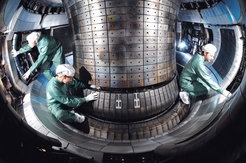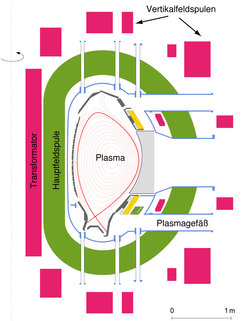Introduction: The ASDEX Upgrade tokamak

ASDEX Upgrade is named axisymmetric divertor experiment after its special magnetic field configuration, viz. a divertor. It allows the interaction between the hot fuel and the surrounding walls to be influenced: The divertor field diverts the outer plasma edge to collector plates. This removes perturbing impurities from the plasma so that the vessel walls are safeguarded and good thermal insulation of the core plasma is attained. This work on ASDEX Upgrade and ASDEX, its predecessor, laid the foundation for the ITER experimental reactor.
To allow experimentation under power-plant-like conditions, essential plasma properties, primarily plasma density, plasma pressure and the wall load, are matched to the conditions in a future fusion power plant.

The coil system is controlled by a computer during a discharge. In real time the computer calculates the actual values for the position and shape of the plasma and corrects the coil currents accordingly to adhere to the target values.
The plasma ring has a radius of 1.60 metre and a volume of 13 cubic metres. Confined by magnetic forces, the plasma hovers in a steel vessel whose inner wall is clad with tiles made of tungsten metal, this being a unique feature world-wide. The confining magnetic field is essentially generated by 16 large copper magnet coils wrapped around the ring-shaped plasma vessel. Along with 17 auxiliary coils – for the divertor, the plasma current, the shaping and positioning of the plasma – and the magnet coil supports, the 9-metre high experiment weighs 800 tons.
Three different plasma heating methods are installed: neutral particle injection with a power of max. 20 megawatts, high-frequency heating with 6 megawatts and frequency tuneable between 30 and 120 megahertz, and microwave heating with 8 megawatts at a frequency of the microwaves of 105 resp. 140 gigahertz.
The fast neutral particles are injected by two injectors through large ports. The high-frequency heating is coupled in by four antennas incorporated in the plasma vessel, each of them being supplied by its own generator. The microwaves produced in four microwave generators, viz. gyrotrons, are fed into the plasma vessel via moveable mirrors.
The plasma is investigated with 40 diagnostics. Up to 4 gigabytes of raw data are recorded per discharge. The measuring results are partly available within less than milliseconds for feedback control of the plasma.
The electrical energy for supplying the magnetic field coils and the plasma heating systems are provided by large flywheel generators.
| Technical data: | |
| Total height of the device | 9 metres |
| Major plasma radius | 1.6 metres |
| Minor plasma radii | 0.5 / 0.8 metres |
| Magnetic field | 3.2 tesla |
| Plasma current | 1.4 megaamperes |
| Pulse length | 10 seconds |
| Plasma heating | 27 megawatts |
| Plasma volume | 13 cubic metres |
| Plasma quantity | 3 milligrams |
| Plasma mixture | hydrogen, deuterium |
| Plasma density | 2 x 1020 particles per m3 |
| Plasma temperature | 100 million degrees |
ASDEX Upgrade dispenses with the use of radioactive tritium as fusion fuel in experimentation. But fusion reactions already occur in the model plasma of ordinary hydrogen and deuterium. To shield the fusion neutrons thereby produced, the experiment was built in a hall with 2-metre-thick concrete walls and a 1.80-metre-thick roof. It can safely capture the annually produced quantity of max. 1019 neutrons. The activation of the apparatus remains so low and decays so fast that the experiment is accessible outside operation times.

